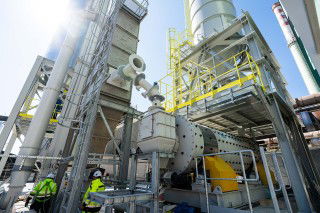This week Indian cement producer JK Cement Ltd announced that it would be expanding its cement production capacity to reach 18Mta by 2022 from 11.1Mta today. Key steps in this initiative are the expansion of the Mangrol cement works in Rajasthan by 3Mta and the construction of a new integrated plant at Panna, Madhya Pradesh.
Underlying the investment decision is primarily the anticipated rise in cement demand in Rajasthan. "Now, projects like smart cities, Sagarmala and housing for all are being taken up and we would have all the growth and demand for the cement industry," said Ranish Kapur, JK Cement's head of business.
The expansion drive is also necessary to enable the company to lower its cost of production and improve plant efficiency to drive profits. Commissioned in 2014, the Mangrol plant currently has a clinker capacity of 2.15Mta and a cement capacity of 2.25Mta. Kiln Line 2 has a five-stage preheater with in-line calciner built by FLSmidth and operates a 5000tpd rotary kiln with a Cross-Bar™ cooler. The plant also operates a thyssenKrupp combi-circuit of roller press and ball mill to grind OPC and PPC.
Fly ash savings
JK Cement has already made significant progress in driving costs down at Mangrol by replacing dry fly ash with cheaper pond fly ash for PPC production, and it has added a hot air furnace in the cement mill for greater pond ash consumption. Fly ash consumption is now up to 32 per cent in PPC production. The company has also introduced an in-house grinding aid to increase savings. In addition, 10 motors have been converted into variable frequency drives to give the plant energy savings of 2000kWh.
Alternative fuels targeted
The company's INR6.23m (US$0.96m) investment in alternative fuels has brought a saving of INR88.81m and the factory now burns agrowaste, liquid mix waste, solid mix waste, fibre mass, sewage sludge and carbon black, which have helped substitute the main fuel, petcoke. The thermal substitution rate (TSR) for alternative fuels reached eight per cent in 2016-17, but the aspiration is to move above 10 per cent.
Investment has also been made in upgrading the main burner to a low-NOx KHD Humboldt Wedag Pyrojet® burner, which has reduced thermal energy consumption by 3kcal/kg of clinker.
Additional investment
Away from the Mangrol plant, the climate of modernisation and investment running through the group continues. At the Jharli plant (Haryana), clinker and cement production has been increased following a INR500m de-bottlenecking and upgrade programme. The clinker cooler on Kiln Line 3 at the Nimbahera plant (Rajasthan) has also been replaced with an IKN Pendulum cooler and a multi-channel burner has been added, improving kiln output from 4680tpd to 5000tpd. Liquid mix waste has also been introduced at the plant. Meanwhile, the 3Mta Muddapur factory (Karnataka) can now process sewage sludge, GEIPL waste and plastic waste.
The Panna plant
The greenfield project at Panna, Madhya Pradesh, will be an integrated plant on 1594ha site near the villages of Kakra, Kamtana, Saptai, Judi, Dervi Purohit and Devra. The project is understood to be awaiting environmental clearance. The estimated cost of the plant is INR5725.8m and will have a proposed clinker capacity of 5.28Mta and a cement capacity of 6Mta. However, the limestone mining rights are expected to be set at the lower capacity of 4Mta, which will give a lifetime of 57 years for the mining operation.
Current portfolio of JK Cement
As of June 2017, the company had 10.5Mta of domestic grey cement capacity with plants in Nimbahera, Mangrol and Gotan in Rajasthan, Jharli in Haryana and the Muddapur unit in Karnataka. At the Gotan works, the company also produces white cement, of which it is the second-largest producer in India. There is also to 0.6Mta Fujairah white cement plant in the UAE. Its operations are supported by 103MW of captive power and 23MW of WHR power installed.
